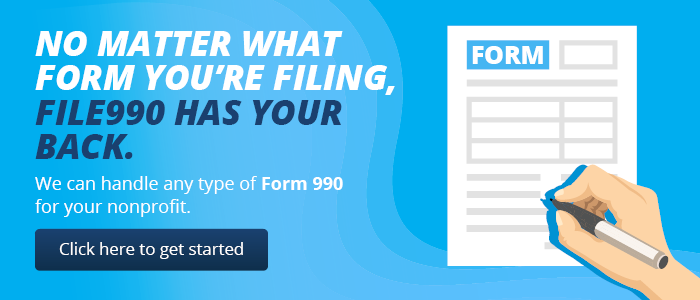Filing IRS Form 990 vs. 990-N: What You Need to Know
December 19, 2018 | 0 Comments

Well, we say no one. Here we refer of course to normal individuals such as yourselves.
We happen to love tax filing.
It’s kind of our thing.
We love it so much, in fact, that we thrive best in the heart of non-profit tax season. Hey, everyone has their niche. Ours is making taxes easier for your organization through File 990’s 990-N and 990-EZ e-filing service.
While we hope to make tax filing as simple and painless as possible for your organization, there are a few things you need to know about the tax forms themselves. What exactly are the different requirements for a regular form 990 versus a 990-N, or e-postcard, form? How are the forms themselves different?
Is the IRS trying to make this whole tax thing complicated?
The answer to that last question is . . . possibly? The answers to the previous questions require a little more in-depth analysis.
This may not be your cup of tea, but knowledge is power.
Knowledge is the difference between your organization’s success and losing its tax-exempt status.
So let’s put our thinking caps on and delve into what the differences in tax forms mean to you and your organization.
Here’s What You Need to Know about Filing IRS Form 990 vs. Form 990-N (e-postcard).
What’s that N Stand for in Form 990-N, Anyway?

The way tax forms are named has a way of making them sound more officious, difficult to parse and mind-numbingly boring.
You can feel the dust settling on your brain when you even try to think about it.
As for that mysterious letter “N,” we can tell you that the full, official name of the form is “Electronic Notice (e-Postcard) for Tax-Exempt Organizations Not Required to File Form 990 or 990-EZ,” per the IRS.
But really, does that help? Does the “N” stand for “Notice”? Or “Not Required to File”? Who cares?
Don’t get caught up in the unappealing, undecipherable form names.
990 filing is much less confusing than it looks.
All you need to know is that form 990-N means your company makes less than a certain amount in revenue, and thus there’s less for you to fill out versus the other versions of the form.
990-N is also, conveniently, an e-file form.
That’s where we come in. More on that below.
Okay, you’re probably thinking, that’s all well and good. But how do I know which form to file? And when is it better to turn to electronic tax filing professionals?
A Head-to-Head Comparison of Form 990-N vs. Form 990
First off, you must file a 990, 990-EZ or 990-N.
After three consecutive tax years of not filing, the IRS will revoke your tax-exempt status.
You typically have until the middle of the 5th month after your tax season ends to file.
Here’s how you know you can file a form 990-N (or e-postcard):
- Your organization’s gross receipts in a fiscal period are $50,000 or less.
- Your organization is not part of a group return.
- Your organization isn’t a church or church-affiliated auxiliary or association.
- Your organization isn’t a political one.
- Your organization isn’t one of the other types that must file a 990 or 990-EZ, such as split-interest trust, group legal services plan, or charitable trust treated as a private foundation.
Once you know you qualify for the 990-N form, that’s half the difficulty of filing. Next you register with the IRS and begin the process. The 990-N is an eight-question electronic form. Once you file it, you’re done!
If you’re still confused and want to make sure you’re dotting all your i’s, here’s the IRS’s complete guide to filing a 990-N e-postcard.
If your non-profit doesn’t qualify, due to either a higher gross revenue or the type of organization, you’ll have to file either a 990-EZ or a full 990 form.
When to File a 990
- Your organization doesn’t qualify for the 990-N e-postcard.
- Your organization doesn’t qualify for the 990-EZ (for gross receipts less than $200,000 and total assets less than $500,000).
- Your organization’s gross receipts are $200,000 or more, and your total assets are $500,000 or more.
- You are not a private foundation who must file a 990-PF.
A full 990 form will be more thorough and require you to provide additional financial information, such as individual programs and their costs, a list of board members and top employee salaries. This information can be used by potential donors to make decisions about giving to your organization.
It’s Time to File your 990. Here’s How an Electronic Filing Company Can Help.
Running a non-profit organization can be very rewarding—but also hectic and challenging. You’re likely dividing your resources to solve any number of problems in any given month.
On top of that, your primary focus will always be the mission statement of the organization itself.
As it should be.
But filing taxes is a constant of life, even if your status is exempt.
Sure, you’re a responsible organization. Your nonprofit is well managed. Sometimes, though, it helps to have someone who has your back come tax season.
File 990 will remind you when it’s time to file your tax forms and help you file, so you won’t lose exempt status. With all the worries that come with running a non-profit, that’s a big one to take off your shoulders.
As an electronic filing company, we’re also flexible when it comes to the types of organizations we work with. We’re delighted to work with small or large organizations that qualify for filing a 990-N or 990-EZ form.
To accommodate this range of customers, we offer our File 990 enterprise system to monitor and maintain tax compliance.
Still have questions about electronic filing for your 990-N, 990-EZ or 990 form? Don’t hesitate to get in touch with File 990. We’d love to help.
Written by Admin


